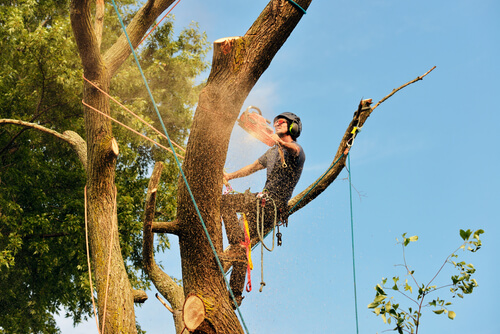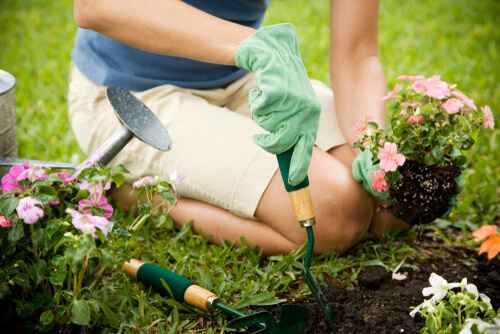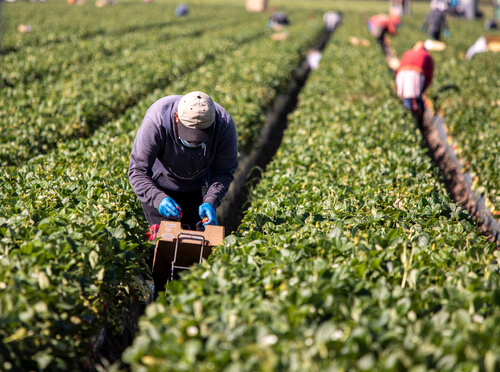- Landscaper
- Greenhouse Worker
- Floral Designer
- Horticulturist
- Arborist
- Gardener
- Farmer
- Botanist
- Agronomist
- Plant Pathologist
#1. Landscaper – Horticulture Job

Landscaper: Average Salary
~ $28,952 per year
Landscaper: Job Description
A landscaper builds and maintains gardens, parks, and other outdoor spaces.
The landscape industry requires a lot of hands-on work, and most landscaping jobs need you to work outdoors in all kinds of weather.
Besides working on municipal, provincial, and federal parks, a landscaper might also work on private lawns, golf courses, nurseries, or greenhouses.
The responsibilities of a landscaper will vary depending upon their experience level and service offerings.
Most landscapers do a variety of horticultural tasks, including measuring and marking areas, preparing the soil, planting trees, shrubs, and flowers, applying mulch and edging around plants, installing irrigation systems, as well as weed control.
Landscaper: Get Started
In general, landscaping jobs do not require a minimum level of education.
A lot of employers allow employees to gain experience on the job.
However, a certification can help applicants acquire advanced knowledge and skills.
A diploma program in landscape design or technology is often available at most colleges. Research the companies that offer landscaping services in your area.
Once you’ve identified a few potential employers, reach out to them directly and express your interest in working for them.
Also, try attending job fairs and networking events.
There, you’ll have the opportunity to meet with representatives from local businesses and learn more about their hiring procedures.
Also read: Office Cleaning Jobs & Platforms
#2. Greenhouse Worker – Horticulture Job

Greenhouse Worker: Average Salary
~ $29,387 per year
Greenhouse Worker: Job Description
A greenhouse worker plants cultivate and harvests trees, shrubs, flowers, and plants. Greenhouse workers typically work in one of three environments, whether indoors, outdoors, or at a greenhouse farm.
Working in a greenhouse involves preparing the soil, planting bulbs, monitoring greenhouse plant health, and regulating greenhouse and outdoor irrigation systems.
If you work with the public, you will need to provide customers with information on gardening, the use of various tools and products, and the care of trees, shrubs, flowers, plants, and lawns.
Greenhouse Worker: Get Started
Most greenhouse worker positions require a high school diploma or equivalent, but some employers may prefer to hire someone with at least one year of college-level coursework in horticulture or a related subject.
On-the-job training is also standard, and many employers conduct it themselves.
To plant and care for plants and flowers in greenhouses, workers must be familiar with industry-standard methods and techniques.
Knowledge of the safe handling of pesticides, fertilizers, plant food formulas, soil additives, fungicides, herbicides, and dust will be a tremendous asset when seeking employment.
There are many places where greenhouse workers can find a job.
Many growers and nurseries post their job openings online.
In addition, some newspapers have classified ad sections that list greenhouse jobs. Local farmworker associations may also be a reliable source for job postings.
Also read: Food Delivery Driver Jobs
#3. Floral Designer – Horticulture Job

Floral Designer: Average Salary
~ $54,292 per year
Floral Designer: Job Description
Floral designers create beautiful arrangements of flowers and foliage for stores and special events, such as weddings, parties, and funerals.
The exact job function you might perform varies depending on where you work.
As a floral designer, you can work in-house for flower shops, grocery stores, event planning companies, caterers, and hotels.
Florists consult with customers to determine their preferences and specifications, advise how to care for different flowers and plants, and ensure that they receive adequate water and are in good condition.
Floral Designer: Get Started
A high school diploma is a minimum education required for most entry-level positions in floral design.
Floral designers who work in higher positions usually need formal accreditation to work within their industry, specifically trained in the cultivation and care of flowers.
Take classes, watch videos, read books, and volunteer at a local flower shop to learn the basics of floral design and more challenging arrangements.
Finding a job is easier when you network with people you know.
You might want to find out if any of your friends or family members own businesses and if they have any recommendations.
Attending local business networking events is another excellent way of getting your name out there.
By meeting other small business owners, you may learn about job opportunities that you would not otherwise hear about.
Also read: No High School Diploma Jobs
#4. Horticulturist – Horticulture Job

Horticulturist: Average Salary
~ $36,583 per year
Horticulturist: Job Description
A horticulturist studies how to grow, harvest, store, process, and ship fruits, vegetables, and decorative plants.
Parks, botanical institutions, flower shows, or large nurseries employ horticulturists.
They can also be self-employed as landscape contractors or run their own businesses importing plants.
Duties vary significantly from job to job, but horticulturists generally plant seeds, tend and harvest plants, monitor plant growth and health, and apply garden chemicals, including fertilizers and pesticides.
A horticulturist will also spend a lot of their time researching issues related to competitiveness and sustainability.
They learn how and where fruits, vegetables, and flowers grow and ways to crop, store, and process plants.
Horticulturist: Get Started
In most cases, the minimum education requirement to work as a horticulturist is a college technical diploma.
Some practitioners, however, may find employment in industries where it is necessary to become certified.
In those cases, a degree in horticulture, botany, agronomy, forestry, or environmental sciences may be beneficial.
There are some things you can do to become a better horticulturist.
Learn as much as you can about plants and gardens, read gardening books and magazines, attend garden lectures, and visit botanical gardens.
Take time to practice your skills! Try designing your garden, planting flowers and vegetables, and caring for houseplants.
You can also join a gardening club or take classes.
Once you develop these skills, you will find many places to discover horticulturist work.
A great place to start is with your local government.
Many municipalities have their own gardens and parks that need tending.
You could also try working for a private company specializing in landscaping or gardening.
Also read: House-Sitting Jobs
#5. Arborist – Horticulture Job

Arborist: Average Salary
~ $41,881 per year
Arborist: Job Description
An arborist maintains trees and woody plants to ensure that they are healthy, safe, and beautiful.
Arborists train in many fields, including tree climbing, tree preservation, park and garden planning, and tree surveying and inspections.
As an arborist, you might work for a company that specializes in tree care, or you might work as an independent contractor that removes trees from private properties.
Typical work tasks include operating heavy machinery and hand tools working in gardens, backyards, parks, and gardens, monitoring forest health, consulting with clients on property matters, and handling emergencies during stormy weather.
Arborist: Get Started
There are no formal requirements, and many opportunities offer on-the-job training, but many arborists have at least a bachelor’s degree in biology, horticulture, or botany.
Certification can improve employment prospects for arborists.
It is also beneficial to search for a possible internship or volunteer opportunity within your area.
Taking part in one of these apprenticeships will give you the skills to work with clients, safely clear debris, quickly identify plants and trees, and use essential maintenance tools.
Once you’ve developed the skills you need to succeed, try applying to companies or organizations offering arborist jobs.
You can find this information online or in trade magazines.
Also read: No Phone Work From Home Jobs
#6. Gardener – Horticulture Job

Gardener: Average Salary
~ $37,050 per year
Gardener: Job Description
A gardener takes care of flowers, plants, vines, vegetables, and fruits.
Since gardeners rarely work on one specific type of job, there is no single place where they work. Individuals or companies can hire gardeners to maintain their own property or company grounds.
Others will look for work at various gardening stores, nurseries, botanical gardens, zoos, arboretums, parks departments, colleges, and universities.
At work, they monitor the health of all plants and greenscape, water and feed plants, trim trees and shrubs, fertilize and mow lawns, weed gardens and keep green spaces and walkways clear of debris and litter.
In addition to knowing how to use and maintain landscaping equipment, such as mowers, trimmers, and fertilizers, gardeners must also adhere to health and safety regulations.
Gardener: Get Started
On-the-job training is usually sufficient for entry-level employment as a professional gardener.
However, an applicant’s job prospects can significantly improve if they have a college degree in landscape design or horticulture.
Volunteering at your local community garden can be a terrific way to improve your skills.
It is a good idea to start your job search by contacting your local extension office.
In most cases, they can assist you in locating job listings for your area.
Also, you can make sure you check out public gardens.
Many of them posted details about open positions on their websites, so see what they have to offer.
Also read: Unique Jobs That Pay Well
#7. Farmer – Horticulture Job

Farmer: Average Salary
~ $45,502 per year
Farmer: Job Description
A farmer grows crops, raises livestock and produces dairy products.
Commercial farmers or agricultural companies employ most farmers, but some own their own private farms.
Each type of farming operation has its own tasks.
A farmer who grows only crops is responsible for preparing the land, planting, caring for the crops, and harvesting them.
Farmers must also take care of their fields by watering, fertilizing, and weeding them to prevent weed competition.
In addition, these farmers may sell their products at a market.
Animal farmers often breed and raise their own animals, though some buy their animals at a young age and raise them for slaughter, show, or sale.
They may raise cattle, sheep and pigs, horses, or bison.
Farmer: Get Started
Most farmers do not need a college degree to start this industry.
However, some farmers earn a business degree or an agriculture degree to help them manage their farms.
No matter your educational background, you can learn more about farming online using many online resources.
Start by connecting with people in the industry by joining online farming communities.
Take part in local agriculture events and meetings, trade shows, conventions, and information sessions.
You can also try to find an internship on a functioning farm.
This will allow you to learn hands-on about everyday tasks and operations on a farm.
You can inquire directly with farms in your area about any open positions.
In no time, you’ll be working on a farm!
Also read: Jobs That Don’t Require A Degree
#8. Botanist – Horticulture Job

Botanist: Average Salary
~ $72,301 per year
Botanist: Job Description
A botanist studies plants and their surrounding environments.
A botanist can practice in a variety of settings.
Some conduct research in universities and educate students.
Others work for the government, studying plant life or creating conservation plans.
They can also work for private companies developing new products or improving crop yields. Research is the most common task a botanist performs.
They may research plant growth, development, function, distribution, and origin.
They might also research environmental issues such as conservation, re-vegetation, and weed control.
Some botanists research how the environment influences plant growth, distribution, and abundance.
Others conduct experiments to enhance crop yield, disease resistance, drought resistance, or nutritional quality.
Botanist: Get Started
A degree in botany, plant science, or plant biology is the minimum educational requirement for most botanists.
Experienced candidates with practical, hands-on knowledge will have the most promising job prospects.
Check your local area for internships, volunteering, and summer work at parks, plant nurseries, farms, labs, and experiment stations to gain valuable experience.
Contact your local conservation organization once you are ready to apply.
Many organizations offer jobs across various disciplines, including environmental education and land management roles, which connect to plants or plant research.
Also read: Low-Stress Jobs For Introverts
#9. Agronomist – Horticulture Job

Agronomist: Average Salary
~ $72,808 per year
Agronomist: Job Description
An agronomist works to improve farm quality and crop efficiency by implementing the latest farming developments.
Agricultural companies, government research organizations, and universities hire agronomists.
They may also consult with local farmers on what are the best ways to improve their crops.
Agronomists generally help farmers use the most effective agricultural practices and collaborate with agricultural research.
They also conduct farmer training sessions and host information sessions for other groups.
Additionally, an agronomist can evaluate crop performance and help solve planting, harvesting, and distribution problems.
Agronomist: Get Started
Holding a degree in agronomy or a closely related field is necessary to become an agronomist.
Consider obtaining one of three primary agronomy certifications: Certified Crop Advisor, Certified Professional Agronomist, and Certified Professional Soil Scientist/Classifier.
If you intend to become a successful agronomist, you must be familiar with the basics of plant biology.
You can use this information to choose suitable crops according to your soil type and climate and diagnose any potential problems.
Each year, agronomists have a choice of thousands of job openings.
Many agronomists find employment through online job boards, industry databases, or educational networks.
Get started with a job search online today!
Also read: Micro Jobs
#10. Plant Pathologist – Horticulture Job

Plant Pathologist: Average Salary
~ $84,071 per year
Plant Pathologist: Job Description
A plant pathologist helps stop diseases and pests from infecting crops and ruining them before harvest time by coming up with ways to better protect the crop from diseases and pests that want to harm it.
A plant pathologist might work for the agricultural industry, private consulting firms, government agencies, or universities. Laboratory, greenhouse, farm, and fieldwork are just a few of the places they can work.
Their work includes conducting crop experiments, advising farmers on-farm improvements, collaborating with scientists to develop ideas about sustainable and environmentally friendly farming practices, and developing ideas about plant genetic modification to advance plant development.
Plant Pathologist: Get Started
Typically, plant pathologists obtain a degree in botany, horticulture, plant pathology, or biology.
Job seekers can do many things to make themselves more marketable to potential employers.
Gain experience with plants like in a greenhouse or nursery.
You can also try attending a research session to learn more about the field and network with professionals.
Make the most of job boards and social media sites to find the perfect job.
Also read: Part-Time Jobs With Benefits
